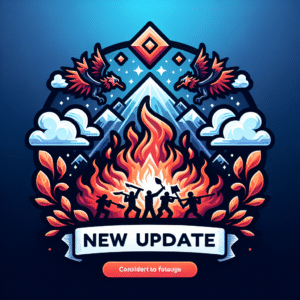Exploring the Rise of Rust: Why Developers Are Choosing It for System-Level Programming
Understanding Rust and Its Origins
Spawned from a personal project by Graydon Hoare in 2006 and later sponsored by Mozilla, Rust has emerged as a favorite among developers for system-level programming. Initially developed as a more secure alternative to C and C++, Rust has succeeded in capturing developer interest due to its focus on safety, concurrency, and performance. In 2015, Rust reached significant milestones, starting with its first stable release, which played a crucial role in its growing adoption.
Emphasis on Safety: From Concept to Code
The pivotal aspect that differentiates Rust from its predecessors is its focus on safety. Traditional system-level programming languages like C and C++ allow direct memory access, which, while offering flexibility, can lead to vulnerabilities like buffer overflows and null pointer dereferences. Rust, however, incorporates a distinct ownership model, a feature that enforces strict rules on memory management through its “borrow checker.” This system ensures that references to data are managed efficiently, reducing bugs even before they occur.
Rust’s ownership model allows developers to write secure and robust code without sacrificing control over system resources. This aspect aligns well with SEO strategies keen on Rust’s potential to mitigate common security flaws prevalent in older languages. Such an approach has been instrumental in building Rust’s reputation as a go-to language for applications where safety is paramount.
High Performance and Predictability
Rust delivers performance levels that are on par with C and C++, making it suitable for system-level programming tasks. The lack of garbage collection, a feature often present in languages like Java or Python, ensures deterministic execution, which is crucial for systems programming. Rust achieves this with zero-cost abstractions, meaning abstractions introduced during development do not impact runtime performance.
The language’s focus on zero-cost abstractions garners attention in SEO as articles emphasize Rust’s ability to write idiomatic code that remains efficient. Furthermore, Rust’s advanced compile-time checks might lead to longer compile times. However, these checks provide the advantage of fewer runtime errors, enhancing speed and predictability.
Concurrency: Simplifying Complex Multi-threading
Concurrency is another area where Rust shines. As processors have evolved into multi-core, parallel execution has become crucial. Rust offers building blocks like threads and futures to handle concurrent computations effortlessly. Its data race prevention capabilities stem from ownership and borrowing principles, ensuring that no two mutable references to the same data exist concurrently.
This feature resonates with developers concerned about concurrent programming leading to unpredictable errors. SEO content revolving around Rust often highlights its capacity to prevent data races at compile time, ensuring that software is free from these challenging bugs, which are notoriously difficult to reproduce and rectify post-deployment.
A Progressive Community and Ecosystem
Rust’s steady rise is also attributed to its thriving community and developing ecosystem. Regularly voted the “most loved language” in Stack Overflow surveys, Rust has cultivated a diverse and supportive community. This support extends beyond forums and meetups into an extensive set of libraries and tools that simplify development tasks.
The Cargo package manager, Rust’s build system and package manager, is integral to this ecosystem. By simplifying dependencies and task automation, Cargo amplifies productivity—a topic that garners frequent mention in SEO-friendly content as it underscores Rust’s developer-centric design.
Rust’s interoperability with other languages is another factor in its growing adoption. Developers are attracted to Rust’s ability to integrate seamlessly with existing systems written in C, promoting gradual migration rather than disruptive rewrites. This compatibility ensures that Rust is both flexible and practical, a dual benefit that is often underlined in Rust-related discussions and literature.
Real-World Implementations and Success Stories
Real-world use cases provide compelling evidence of Rust’s applicability in system-level programming. Companies like Mozilla, Dropbox, and Microsoft leverage Rust in critical infrastructures. For Mozilla, Rust proved invaluable in developing components of the Firefox browser, particularly in the Servo engine, due to its safety and performance features.
Dropbox’s use of Rust in storage infrastructure further highlights the language’s reliability and efficiency, reducing memory usage and enhancing speed. Microsoft’s exploration of Rust involves integrating it into safe system components, particularly within Azure, underscoring its potential in scalable, cloud-based environments.
Adoption Challenges: Overcoming the Learning Curve
Despite its advantages, developers transitioning to Rust face a learning curve, primarily due to its ownership model and strict type system. This steep learning curve is frequently acknowledged in discussions about Rust, given that mastering these concepts is crucial for taking full advantage of the language’s capabilities.
Community-driven educational resources and rich documentation have been pivotal in easing this transition. Rust’s official resources, alongside third-party tutorials and webinars, contribute significantly to these efforts, ensuring that the language remains accessible to newcomers. The buzz around learning Rust, its challenges, and resolutions naturally fits into SEO strategies aimed at onboarding newbies to the language.
Future Prospects and Opportunities
The trajectory of Rust indicates a promising future. Its adoption beyond traditional system programming into fields like blockchain, game development, and web assembly showcases its versatility. Blockchain platforms leverage Rust for writing secure smart contracts, while game developers appreciate its performance capabilities.
Web Assembly represents another frontier for Rust, allowing developers to run Rust code on the web when combined with the Wasm toolchain. This adaptability opens new avenues for developers seeking to use Rust across different technological domains, driving future content that emphasizes Rust’s expanding role in software development.
Addressing Sustainability and Scientific Applications
Sustainability in software development involves creating long-lasting, reusable, and adaptable codebases. Rust contributes by enhancing code stability, reducing maintenance burdens thanks to the compiler’s assistance in catching bugs early in the development cycle. This aspect makes Rust attractive for scientific computing, where precise mathematical operations and algorithms are of utmost importance.
Rust is gradually gaining traction among scientists and researchers aiming for performance-intensive computations without compromising reliability. Its increasing use in data analysis and machine learning further exemplifies its potential to revolutionize fields that require a balance between high computation speed and exact results, areas frequently discussed in SEO content highlighting Rust’s benefits in academia.
Community-Inspired Innovations
Rust’s governance model, which grants significant input from its vibrant community, has led to many user-inspired features and updates. This collaborative approach ensures the language evolves to meet user needs, keeping it relevant amid rapidly changing tech landscapes.
The consistent engagement and contributions to the Rust language are reflective of its growing importance and utility. SEO-focused content on Rust often emphasizes the language’s dynamic development lifecycle, catering to developers eager to participate in its evolution.
Integrating these aspects provides a comprehensive understanding of Rust’s role in system-level programming, underscoring why it has become a preferred choice for a multitude of developers worldwide seeking safety, speed, and a strong developmental community.













Post Comment